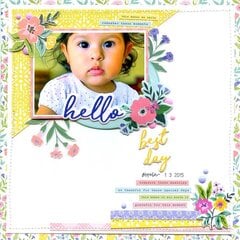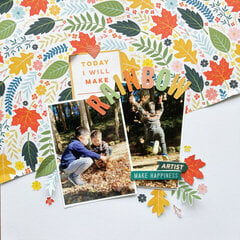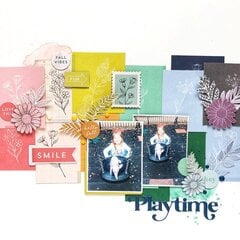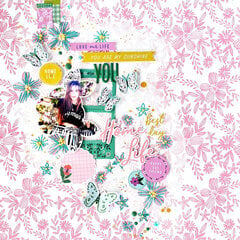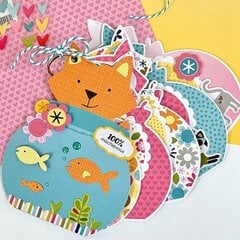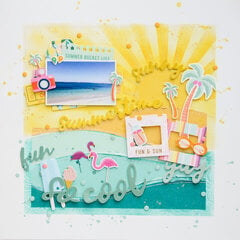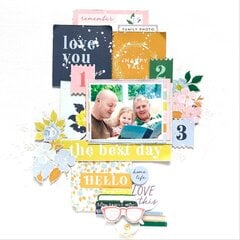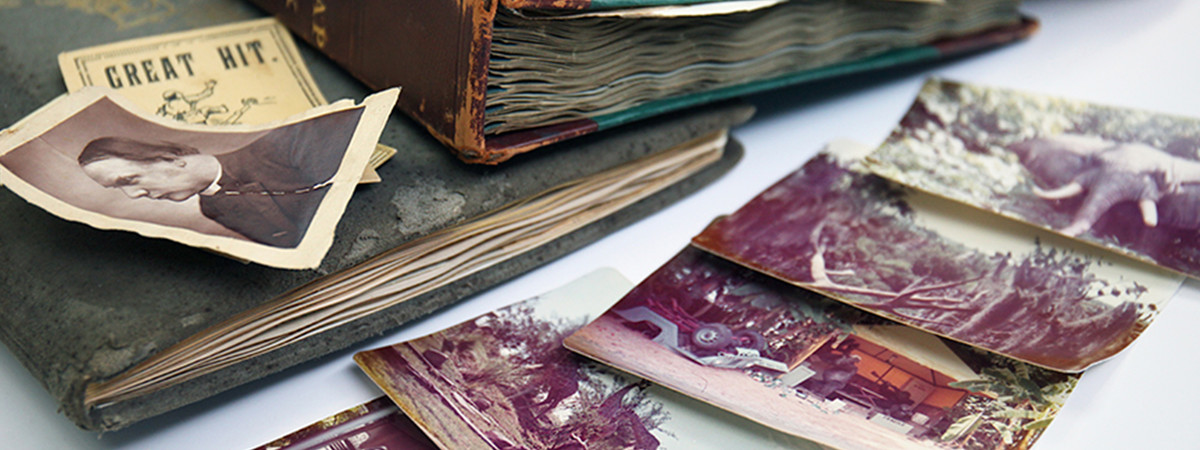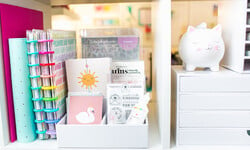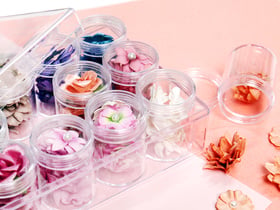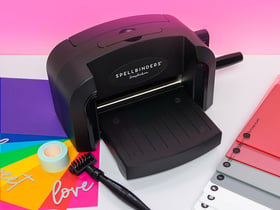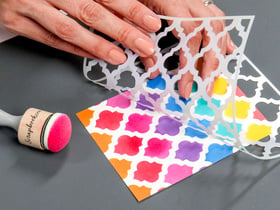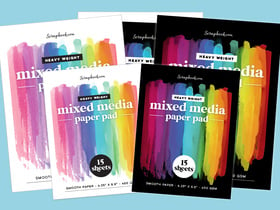Have you ever wished for a glimpse into the real life of someone famous or from long ago? Have you ever wished you could experience history as it was experienced by those who lived it? Hiding in archives and attics, scrapbooks from the 19th and 20th centuries can provide just that – an intimate, first-hand look at history created by the people who lived it, existing in the pages of a scrapbook album.
Famous People Who Scrapbooked
Mark Twain

Mark Twain, 19th century author of the classics The Adventures of Huckleberry Finn and Tom Sawyer, was an avid traveler – and an avid scrapbooker about his travels, even taking his scrapbooks with him to chronicle his trips as they happened. The immensely popular self-pasting scrapbook that he patented in 1872 is widely believed to have been his bestselling “book”, earning him as much as $100,000 in sales. More than three dozen of Twain’s scrapbooks still exist today in the Mark Twain papers held at The Bancroft Library at the University of California-Berkeley.
Fun Fact: Scrapbook.com owns one Mark Twain invented self-pasting scrapbook! See photos of it here!
Lewis Carroll

Another author of 19th century classic literature, Lewis Carroll, also left behind scrapbooks. Known for writing the children’s classics Alice in Wonderland and Alice Through The Looking Glass, Carroll’s scrapbook that covers the years 1855 to 1872 is in the Library of Congress and has been digitized for easy public access. The scrapbook contains mostly newspaper clippings and photographs, along with some personal annotations by Carroll.
The Fitzgeralds

In the Special Collections of Princeton University library, the Jazz Age lives on through the archives of author F. Scott Fitzgerald and his wife, Zelda. The two were icons of the 1920's era of flappers and speakeasies that was immortalized in F. Scott Fitzgerald’s classic book The Great Gatsby. Zelda Fitzgerald kept a scrapbook from her childhood years in Alabama through the early part of her marriage to F. Scott, ending in 1926.
F. Scott Fitzgerald was a more prolific scrapbooker, filling a half-dozen scrapbooks with news clippings and other items. The scrapbooks’ principal topic is his literary accomplishments, but they also include some other bits and pieces from his life and travel. Fitzgerald biographers believe that his scrapbooking may have been inspired by his mother, who recorded his early years in a scrapbook. The entire Fitzgerald collection at Princeton Library has been digitized and is available for the public to view online.
Amelia Earhart

Amelia Earhart generated a flurry of publicity for her pioneering aviation accomplishments in the 1930s, like her flight across the Atlantic Ocean and her doomed attempt at a round-the-world flight. She, along with her husband George Palmer Putnam, curated a 19-volume scrapbook collection of newspaper clippings of that publicity.
There are also clippings about the activities of other female aviators of the period. The entire 19 volume set is digitized and available to view online as part of the George Palmer Putnam collection of Amelia Earhart papers at Purdue University Libraries.
T.S. Eliot
20th Century poet T.S. Eliot found great love late in life. By the time he married his second wife Valerie Fletcher in 1957, he was already a Nobel Prize winner for works like “The Love Song of J. Alfred Prufrock” and “The Waste Land”. (Posthumously, he reached even more fame when his short book of poems “Old Possum’s Book of Practical Cats” became the basis of the hit musical Cats in 1981.)
Fletcher and Eliot created eight scrapbooks together in the short years of their marriage before Eliot died in 1965. The scrapbooks are reportedly filled with scraps of their life together, from their wedding planning, to their outings to the theatre and dinner parties. Privately held in the archives of the T.S. Eliot estate, the scrapbooks are not available for public viewing.
Sir Cecil Beaton
You may not recognize Sir Cecil Beaton’s name, but you will almost certainly recognize his photographs. Known for his portraits of celebrities and royalty from the 1930s through the 1970s, he took the historic coronation photos of Queen Elizabeth II in 1953 along with the infamous wedding photos of The Duke and Duchess of Windsor in 1937.
The multi-talented Beaton also won Tonys and Oscars for developing the costume design of classics like Gigi and My Fair Lady. Beaton used his scrapbooks as part of his creative process in the visual arts that he practiced. The books are a seemingly random mash of photos of celebrities, clippings of images, along with mementos of his life. Beaton first published some of the pages of his travel scrapbooks in book form in 1937.
In 2010, art publisher Assouline produced a coffee table book of selected pages from Beaton’s scrapbooks, which were owned at the time by Sotheby’s.
Andy Warhol

Andy Warhol, the artist who pioneered pop art in the 1960s, is famous for his brightly colored paintings of celebrities like Marilyn Monroe (and Campbell’s Soup cans). Warhol’s life and art were infused with his love of celebrity and fame, an obsession that began when he was growing up in the 1930s watching movies in the local Pittsburgh movie theatres.
His first scrapbook was created during that time, which contained a collection of pictures of the celebrities that he idolized. When he became famous himself, Warhol assembled 42 scrapbooks full of clippings chronicling his accomplishments and celebrity. Today, these volumes are held in the archives of The Andy Warhol Museum in Pittsburgh, Pennsylvania.
Woody Guthrie
Folk singer Woody Guthrie, most famous for his song “This Land is Our Land”, influenced generations of folk singers who came after him like Pete Seeger, Bob Dylan, and his son Arlo Guthrie. His legacy is recorded in seven scrapbooks housed in the Woody Guthrie Center in Tulsa, Oklahoma. Several were assembled by his manager to record his career, but one of them was assembled by Guthrie himself in 1941-1942. Another tells the history of the family from 1911 to 1945.
Walt Disney
The parks he created have launched a million scrapbooks, so it is fitting that Walt Disney should have his own scrapbook. In 2015, a World War I-era scrapbook containing the earliest surviving original sketches by Walt Disney surfaced when it was listed for auction. The scrapbook was one given to service members by the Red Cross, and Disney used it as a sketchbook while serving as a volunteer ambulance driver in France in 1918. The scrapbook covers a range of common themes from the war, including several sketches of trench rats, which are the first known cartoons of rodents by Disney!
Queen Victoria

When she was only 18 years old, Princess Victoria became the Queen of the United Kingdom of Great Britain and Ireland, her reign lasting from the summer of 1837 to January of 1901! Her impressive, long-lasting reign held another impressive treasure from her childhood - a scrapbook that was put together by her governess, Baroness Louise Lehzen of Germany.
Her beautiful, red bound scrapbook is small and contains irreplaceable treasures, such as lockets of her hair, journaling, received stationery, fabric from her wedding dress, and more glimpses into the life of the young queen.
You can see some pages of Queen Victoria's scrapbook here.
Claudia Sanders
If you are going to make a scrapbook, you might want to make sure that you don’t put a billion-dollar family secret in it. A scrapbook belonging to Claudia Sanders recently resurfaced in the hands of her nephew. While Claudia Sanders’ name may be unfamiliar to most, the name of her husband is: Colonel Harland Sanders, of KFC fame. On one page in Claudia Sanders’ scrapbook is a striking handwritten list. Are those the 11 herbs and spices? Sanders’ nephew told the Chicago Tribune he believed they were. But only the Colonel knows for sure!
Joan Rivers
After comedian Joan Rivers died in 2014 at age 84, her daughter Melissa described her as “a hoarder.” It was no exaggeration. By the time of her death, Rivers had accumulated an astounding 55 scrapbooks during her life and her decades in Hollywood and had an immense archive of papers saved from her life’s work in comedy.
The scrapbooks, dating from 1959, contain reviews (even bad ones) and news clippings about her career. In 2017, Melissa Rivers published “Joan Rivers Confidential: The Unseen Scrapbooks, Joke Cards, Personal Files, and Photos of a Very Funny Woman Who Kept Everything”, a selection of items found in her mother’s scrapbooks and papers that tell her mother’s life story.
Politicians Who Scrapbooked
Thomas Jefferson

Thomas Jefferson, one of the founding fathers of the United States and the country’s third president, somehow found the spare time to scrapbook as well! From 1801 to 1809, while he was president, Jefferson assembled four small scrapbooks containing hundreds of poetry clippings accompanied by his handwritten notations about them. The original scrapbooks are hidden away safely in the Jefferson archives of the University of Virginia Library. But if you’d like to read the contents, and some explanation of them, they can be found in the book, Thomas Jefferson’s Scrapbooks by Jonathan Gross.
The Roosevelts

The family of 26th president of the United States, Theodore Roosevelt, is extensively documented in scrapbook form. Between 1881 and 1899, Roosevelt himself assembled eleven scrapbooks that contained clippings about his career and accomplishments in the military’s Rough Riders and as Governor of New York. These scrapbooks are now in the Houghton Library of Harvard University. Starting around 1910, Theodore Roosevelt Jr’s wife Eleanor Butler Roosevelt began recording the Roosevelt family’s life and history in dozens of scrapbooks that now reside in the Library of Congress.
Jackie Kennedy

Notoriously private First Lady (and fashion icon) Jackie Kennedy treated her scrapbooks with the same level of privacy she treated the rest of her life. Even nearly a quarter-century after her 1994 passing, her lifetime of scrapbooks remains locked away in the archives of the John F. Kennedy Presidential Library, unseen by anyone. Only one scrapbook by the elusive Mrs. Kennedy has ever been seen by the public. That book was a thank you gift given to her close friend Bunny Mellon, commemorating Mellon’s assistance in creating the now-famous White House Rose Garden. This album, which now resides in the Library of the Mellon - founded Oak Spring Garden Foundation, was digitized to be displayed as part of a special 2015 White House Historical Association exhibition on the history of the Rose Garden.
Barbara Bush

First Lady Barbara Bush started scrapbooking long before she moved into the White House in 1989. Her first scrapbook was created when she was still in high school, and it records her earliest dates with her future husband (and U.S. president) George H.W. Bush. Mrs. Bush continued scrapbooking for more than 70 years. The result was 118 scrapbooks of Bush family and political history. These albums are now in the archives of the George H.W. Bush Presidential Library at Texas A&M University. To protect the originals, digitized versions of the albums are available at the library for research use. Some items from the scrapbooks have been duplicated and become part of the Library’s historic displays.
Scrapbooks That Chronicle Movements
Abolition
American writer Henry David Thoreau (famous for the book Walden and essay “Civil Disobedience”) was a well-known slavery abolitionist in the 1830s to 1860s. Perhaps lesser known is that his sister, Helen Thoreau, was also an activist for abolition, being one of the leaders of the Concord (MA) Female Anti-Slavery Society. The scrapbooks of anti-slavery news clippings that of which she led the assembly served as inspiration for and education of the abolitionist activists. Several of these scrapbooks are digitized and available for viewing on the website of Middlebury College’s Abernathy Collection, here and here.
It was an 1837 visit by the Grimké sisters that led to the founding of the Concord Female Anti-Slavery Society. Angelina Grimké and her sister Sarah Grimké were controversial and outspoken southern slavery abolitionists who lived most of their lives in the north. In 1839, they published a book called American Slavery As It Is: Testimony of a Thousand Witnesses, along with Angelina’s husband Theodore Weld. The book recounted the actual treatment of slaves by their owners, based on a scrapbook of newspaper accounts assembled by their group. It is still considered today to have been a powerful tool in the abolitionist movement.
Prohibition
The Women’s Christian Temperance Union, a late 19th and early 20th century women’s movement to support prohibition, seems to have taken a few pages from the example of slavery abolitionists – scrapbook pages, that is. Many archives of W.C.T.U. records contain scrapbooks maintained by local chapters that contain clippings of news related to the prohibition movement. In the archives of the Rhode Island Historical Society, about a half-dozen scrapbooks from various W.C.T.U. chapters in the state can be found. The Monroe County Local History Room & Museum in Sparta, Wisconsin holds three scrapbooks from the county chapter of W.C.T.U. recording the organization’s activities on a local, state, and national level.
Suffrage
Another women’s movement was building at the same time as the temperance movement – and it used scrapbooking as an organizational tool as well. The suffragist movement to secure women the right to vote in the United States followed much the same model as the W.C.T.U. (In fact, there was a crossover between the two movements as the temperance activists believed their cause would be advanced by having the right to vote.) The Library of Congress contains the archives of the National American Women Suffrage Association. Included in those records are seven scrapbooks compiled by Elizabeth Smith Miller and her daughter Anne of the Geneva (NY) Political Equality Club between 1897 and 1911. The Millers, active suffragists, recorded the activities of the local group they’d founded, as well as events they attended with nationally prominent activists.
Historically Notable Scrapbooks
Civil War Album
Henry Mitchell Whitney, a Union soldier during the Civil War, went to great lengths to assemble his scrapbook of what he saw during his time fighting in the war. Whitney, who later graduated from Yale and became a literature professor at Beloit College, carefully mailed home to his family some items and carried other items in his backpack. Later, he assembled them all into a scrapbook of his experiences in the South during the war. It included news items about himself and his regiment, memorabilia, and military documents. This Civil War album, along with three others made by Whitney, are now housed in the Beloit College archives.
Scrapbook of President James Garfield
James Garfield is an often-forgotten U.S. president. He was only president for a few months before being shot and killed in 1881. But in the President James Abraham Garfield Papers at the Western Reserve Historical Society are some scrapbooks containing important historical documentation of his political career. One is a scrapbook compiled by Garfield’s son-in-law and private secretary Joseph Stanley Brown of documents exonerating Garfield of alleged improprieties in the awarding of military contracts. Another is a scrapbook of sympathy messages sent to the Garfield family after the assassination.
New York Fire Department
Scrapbooks are still used even today in the digital age as a powerful form of institutional memory. From 1906 to 1909, Company 62 of the New York Fire Department used a scrapbook as their unit’s institutional memory. The company collected a hundred pages of memos, letters, and notes about day-to-day life at the firehouse, including memorializing fallen colleagues, and organized them in an indexed scrapbook. Villanova University acquired the scrapbook via an eBay auction and a digital copy is now posted online for public viewing.
The Alexander Gumby Collection of Negroiana
Alexander Gumby was actually nicknamed “Mr. Scrapbook” for the encyclopedic collection of scrapbooks he assembled about African-American history in the first half of the 20th century. Gumby was a part of the Harlem Renaissance movement that included better-known names like Langston Hughes. Eventually Gumby’s scrapbooks grew to over 150 volumes that were organized by topic. Some were devoted to prominent African-Americans (like Booker T. Washington) and others were devoted to topics like lynching or the South. In 1950, the collection was donated to Columbia University, where Gumby previously worked as a waiter. The Alexander Gumby Collection of Negroiana is publicly available to view on microfilm at the Rare Book & Manuscript Library at Columbia.
Gawronski's Scrapbook
Like many teenagers, Billy Gawronski was obsessed with his hero. He filled a scrapbook with the exploits of his hero, explorer Robert E. Byrd. But Gawronski wanted more than scrapbooks. He was determined to go on Byrd’s expedition to Antarctica to attempt to reach the South Pole that was departing in 1928. It took four attempts, but Gawronski managed to stow away and go all the way to Antarctica with the expedition. Gawronski’s scrapbook is now in the private collection of his wife Gizela, but it was used as material for the recent book “The Stowaway” by Laurie Gwen Shapiro about his journey.
Laura Fitzpatrick's Scrapbook on Brooklyn
From 1938 to 1948, Laura Fitzpatrick used her camera to record the people in her Brooklyn neighborhood. She photographed her family, friends, and neighbors, documenting the more than 500 resulting photos in a scrapbook. Today, her scrapbook is in the collection of the National Museum of African American History & Culture in Washington D.C., and some of her photos are on display in the museum’s Everyday Beauty exhibit.
Scrapbooks from the USS Constitution
USS Constitution, launched in 1797 and named by George Washington, is today the oldest commissioned naval vessel in the world that is still afloat. In the early 1930s, she was just starting her days as a museum ship. After she was refurbished, the USS Constitution was sent on a three-year, 90 city national cruise. The USS Constitution Museum collection includes several scrapbooks created by the ship’s crew members of that trip. The albums contain a variety of news clippings, postcards, memorabilia from port visits, photographs, and shipboard items.
Old scrapbooks, seen too often selling for bargain prices at flea markets, are actually invaluable pieces of history. They provide a wealth of information to historians and biographers about the lives of famous and not-so-famous people. They tell the stories of events and social movements not through the clear eye of history, but through the cloud and confusion of the current time. They provide small, personal perspective on grand events. They tell us the personal stories behind the works of gifted writers and artists. They give us a glimpse of what life was like in bygone eras.
The search for old scrapbooks can be a treasure hunt that has the potential to lead to a myriad of places. They are hiding in archives, libraries, attics, antique stores and flea markets. Those whose makers were famous in their own lifetime are relatively easy to track down. Others, passed down through families, may end up donated to local historical archives, sold or even destroyed.
Scrapbooking is more than just a way to preserve and display your pictures. It is a way to tell your own story, write your own biography for future generations, and share the slice of history that you experienced. It’s not just a gift to your children and their future generations. It’s also a gift to generations of historians.


